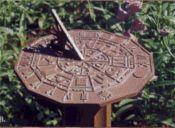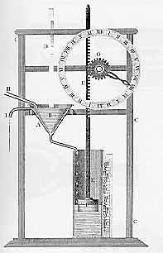

Billie Silvey
Marking Time
Sun Clocks. One of the earliest
forms of clock was the sundial, a
device first used in Egypt around
3500 B.C. in which the angle of
the sun casts a shadow on a â
€œfaceâ€� divided into hours.
Cleopatra’s Needles were tall
obelisks whose shadows marked
time on 12 marks on the ground.
Another shadow clock was more
portable. It used five variably
spaced marks and an elevated
crossbar. At noon, it was turned
around to measure the afternoon
hours.
Sundials use the sun to tell time,
and thus can only be used on
sunny days.
forms of clock was the sundial, a
device first used in Egypt around
3500 B.C. in which the angle of
the sun casts a shadow on a â
€œfaceâ€� divided into hours.
Cleopatra’s Needles were tall
obelisks whose shadows marked
time on 12 marks on the ground.
Another shadow clock was more
portable. It used five variably
spaced marks and an elevated
crossbar. At noon, it was turned
around to measure the afternoon
hours.
Sundials use the sun to tell time,
and thus can only be used on
sunny days.
January 2006
Water clocks. Next came water
clocks, or clepsydra, around 1400 B.C.
Water clocks used two containers of
water, one higher than the other. Water
traveled from the higher to the lower
through a tube. Marks on the containers
told the time.
Clepsydra were invented in Egypt but
improved repeatedly over the years by
the Greeks.
Later water clocks used gears and
faces. They told time at night as well as
day and were more accurate than
sundials.
clocks, or clepsydra, around 1400 B.C.
Water clocks used two containers of
water, one higher than the other. Water
traveled from the higher to the lower
through a tube. Marks on the containers
told the time.
Clepsydra were invented in Egypt but
improved repeatedly over the years by
the Greeks.
Later water clocks used gears and
faces. They told time at night as well as
day and were more accurate than
sundials.
Mechanical clocks. In the early 14th century, large
mechanical clocks began to appear in clock towers in
Italian cities. These public clocks were weight driven
and were hard to regulate.
Peter Henlein of Germany invented the spring-
powered clock around 1510. This clock slowed
down as the spring unwound. But the spring made it
possible for the timepieces to be smaller and more
portable.
Jost Burgi added a minute hand in 1577. Glass began
to be used to protect the face of the clock in the 17th
century.
Clocks weren’t very accurate until 1656, when the
Dutch scientist, Christian Huygens, made the first
pendulum clock. It was correct to within a minute a
day. As the pendulum swings, it turns a wheel with
teeth, which turns the hour and minute hands on the
clock face. The primary problem with pendulum
clocks is that they have to be restarted on a regular
basis.
The first pendulum clock with external batteries was
made around 1840. By 1906, the batteries had been
moved inside the clock.
mechanical clocks began to appear in clock towers in
Italian cities. These public clocks were weight driven
and were hard to regulate.
Peter Henlein of Germany invented the spring-
powered clock around 1510. This clock slowed
down as the spring unwound. But the spring made it
possible for the timepieces to be smaller and more
portable.
Jost Burgi added a minute hand in 1577. Glass began
to be used to protect the face of the clock in the 17th
century.
Clocks weren’t very accurate until 1656, when the
Dutch scientist, Christian Huygens, made the first
pendulum clock. It was correct to within a minute a
day. As the pendulum swings, it turns a wheel with
teeth, which turns the hour and minute hands on the
clock face. The primary problem with pendulum
clocks is that they have to be restarted on a regular
basis.
The first pendulum clock with external batteries was
made around 1840. By 1906, the batteries had been
moved inside the clock.





Hourglasses. Hourglasses
use the flow of sand through
a restricted opening between
two containers.
The earliest reference to
hourglasses or sand glasses
was in a shipping manifest in
1345. Hourglasses were
common in Italy by the 14th
century.
use the flow of sand through
a restricted opening between
two containers.
The earliest reference to
hourglasses or sand glasses
was in a shipping manifest in
1345. Hourglasses were
common in Italy by the 14th
century.

Electronic clocks. Quartz clocks, invented in 1920, use a type
of crystal that looks like glass. Electricity causes the quartz crystal
to vibrate at a high rate of speed. This vibration moves the clockâ
€™s hands very precisely.
Sources for this article included: ARCYTECH.org, About.com,
and the website of the National Institute of Standards and
Technology, physics.nist.gov.
of crystal that looks like glass. Electricity causes the quartz crystal
to vibrate at a high rate of speed. This vibration moves the clockâ
€™s hands very precisely.
Sources for this article included: ARCYTECH.org, About.com,
and the website of the National Institute of Standards and
Technology, physics.nist.gov.
